Watched by millions of people annually, the Changing of the Guard in London is one of those iconic ceremonies that everyone should see at least once. Check out this must-read guide before you go.
London is a fascinating city – on the face of it, it’s fiercely cosmopolitan – packed with skyscrapers, cool bars and quirky things to do.
But tradition still lives strong. There are age-old ceremonies and historic landmarks dotted all over London.
Few are more popular than the iconic Changing of the Guard, which takes place at Buckingham Palace.
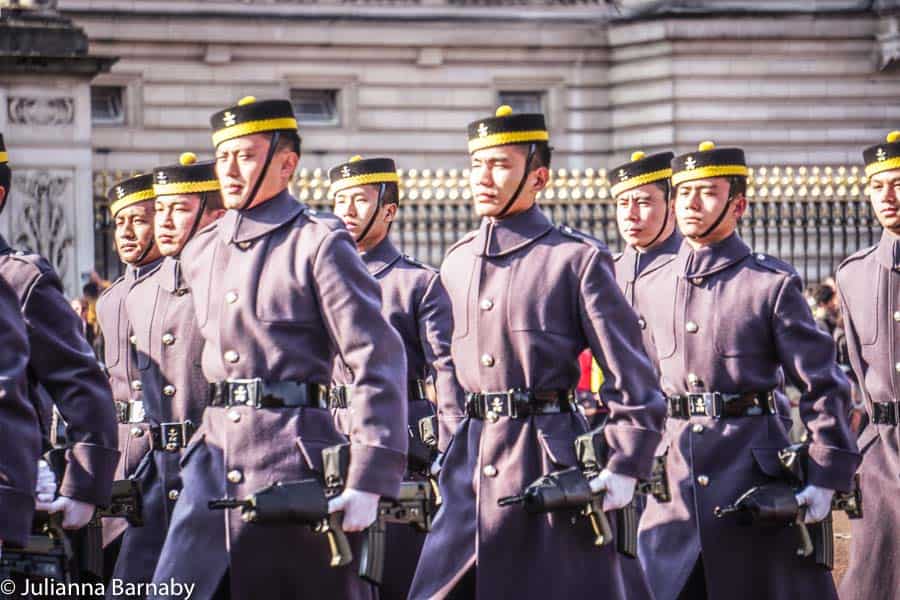
Can we make a confession? Until recently it had been years since we had seen The Changing of the Guard.
This fabulous ceremony that’s an intrinsic part of London’s fabric, full of pomp and circumstance is one that we’ve been too busy doing other things to make time to add to our London itinerary. Facepalm.
Don’t make the same mistake – whether you’re a first-time tourist or a battle-hardened Londoner, This is an unmissable London experience.
If you’re planning to go and see the ceremony (and you totally should), this is what you need to know.
What is the Changing of the Guard?
The Changing of the Guard is the official ceremony where the Foot Guards currently guarding the monarch (the Old Guard) are released from duty, to be replaced with new soldiers (the New Guard).
It might sound confusing, but it’ll soon make sense once you witness this cool London tradition in the flesh.
Kings always had armies of men protecting them, yet the King’s (or Queen’s) Guard wasn’t an official institution until Henry VII made the Royal Body Guard a permanent job fixture.
Since then, soldiers have been guarding Kings and Queens for over 520 years – in other words, they’re pretty good at their jobs.
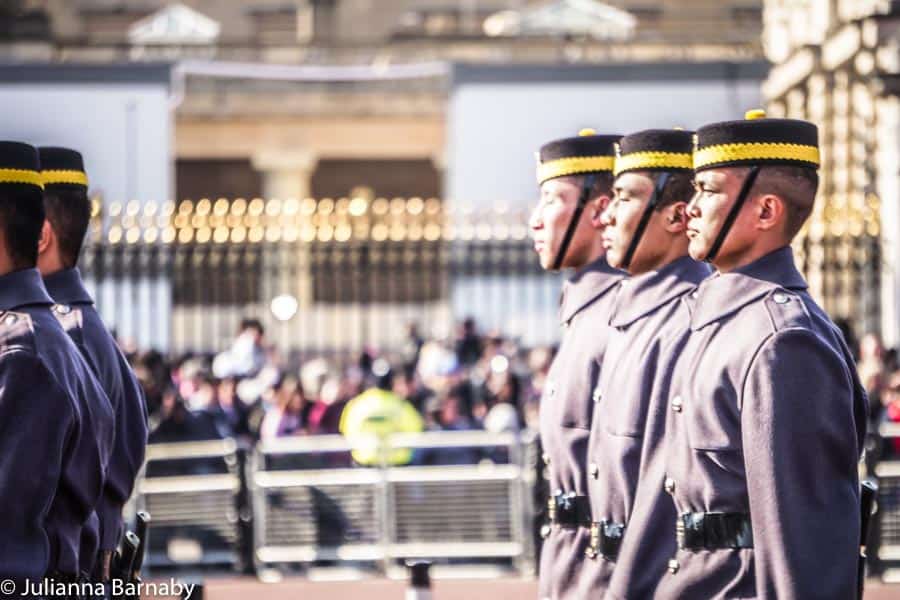
The Old Guard hands over the responsibility for protecting the palace to the New Guard – along with a ceremonial set of keys to Buckingham Palace. This is officially known as Guards Mounting.
The Guards Mounting ceremony is carried out by soldiers from the Foot Guards – you know the ones, the dudes with the massive black bearskin hats and bright red tunics (well, they’re grey during wintertime to match the London skyline and keep the guards nice and warm, but you get the point).
What could be a simple changeover is elevated to a striking military procession, with a series of marches impeccably executed by these experienced guards.
Visually impressive, the ceremony is lent extra gravitas by the accompanying music played by the Guards Bands.
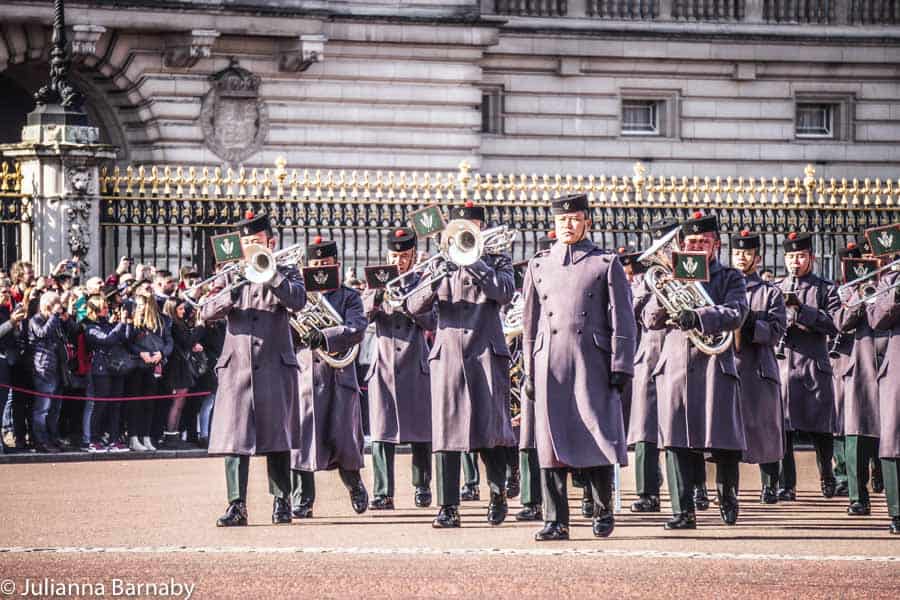
You could be forgiven for thinking that the band only plays traditional marching music – but you’d be completely wrong.
The music ranges from old military marches to well-known pop songs – the James Bond theme tune is a particular favourite, while the Game of Thrones theme tune has been known to pop up from time to time too. Don’t expect them to play any requests, though.
Head there and try to identify which songs are playing – you might just recognise one.
Read More: Cool Facts about London
How to See The Ceremony?
Believe it or not, you have three different ceremonies that are referred to as the Changing of the Guard to choose from.
The best-known takes place at Buckingham Palace, but another ceremony also takes place down the road at Horse Guards and yet another in a short drive or rail trip away in Windsor (where the King has another one of his many castles).
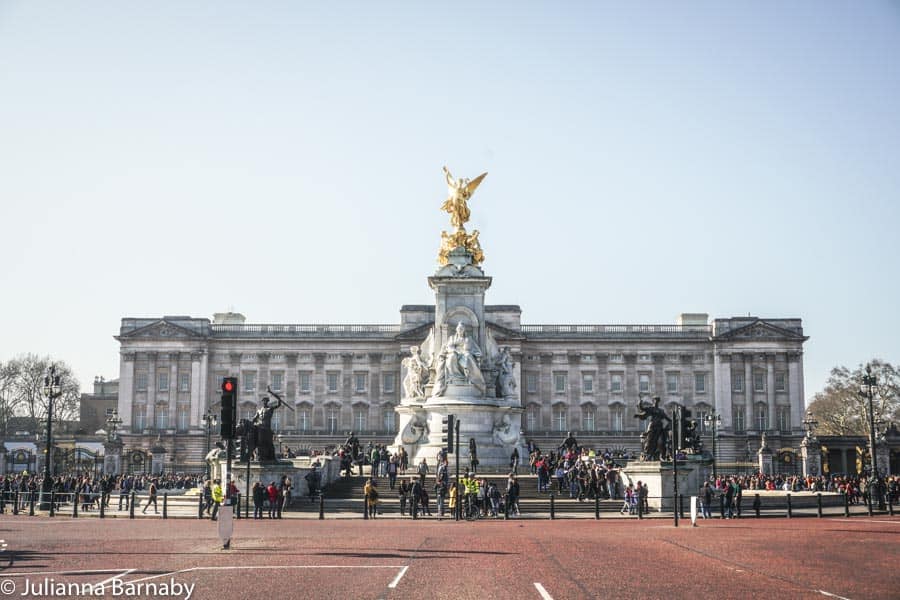
The Buckingham Palace ceremony is the biggest (and the best?), so this is what we’ll focus on in this article, but we’ve also included a section on the Horse Guards ceremony if you want to go and check that out too.
Where Should I Watch the Buckingham Palace Changing of the Guard?
You have five main options for watching the Buckingham Palace ceremony: Friary Court in St James’s Palace, The Mall, The Victoria Memorial, Buckingham Palace Gate and Wellington Barracks.
We recommend watching the ceremony from The Victoria Memorial if you can, or around Buckingham Palace Gate for the best views.
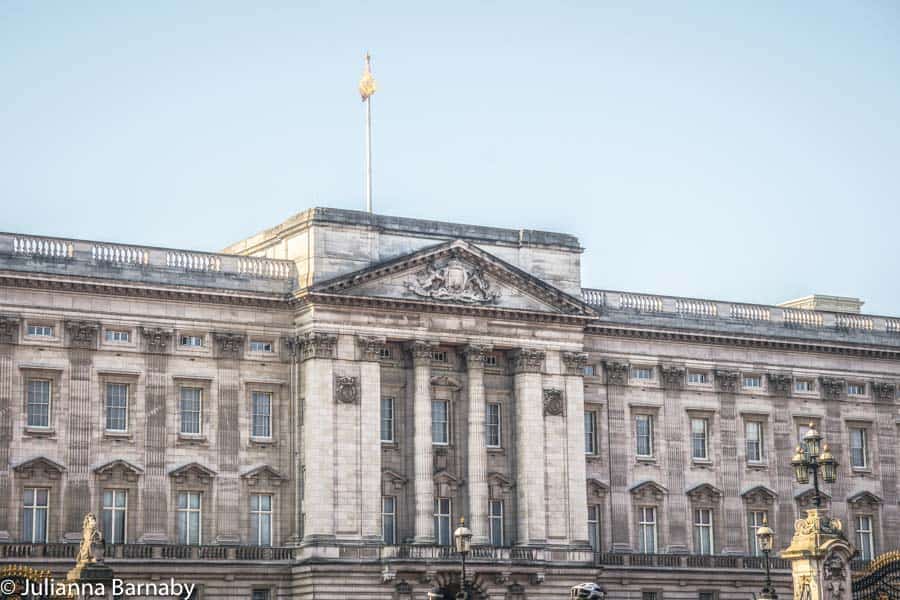
Both have the advantage of being at the centre of the action giving you the perfect vantage point to see the New Guards arriving, the handover ceremony and then the Old Guards departing.
If you’re stood on the Victoria Memorial, you can get a pretty good view of the ceremony from the raised steps – all this without having to get there ridiculously early like you would if you wanted to get to the front at the gates themselves.
The other three spots (The Mall, St James’s Palace and Wellington Barracks) are much less busy, but if we’re honest, they don’t offer the same experience – nothing beats viewing it right in front of the imposing gates at Buckingham Palace.
If you’re visiting london, we recommend checking it out at Buckingham Palace, yet if you have time for a couple of visits, prioritise Buckingham Palace before heading to Horse Guards or Windsor for a different experience.
You can also book onto this Changing of the Guard Guided Tour for an in-depth behind-the-scenes look..
When is the Changing of the Guard? What Times Does it Happen?
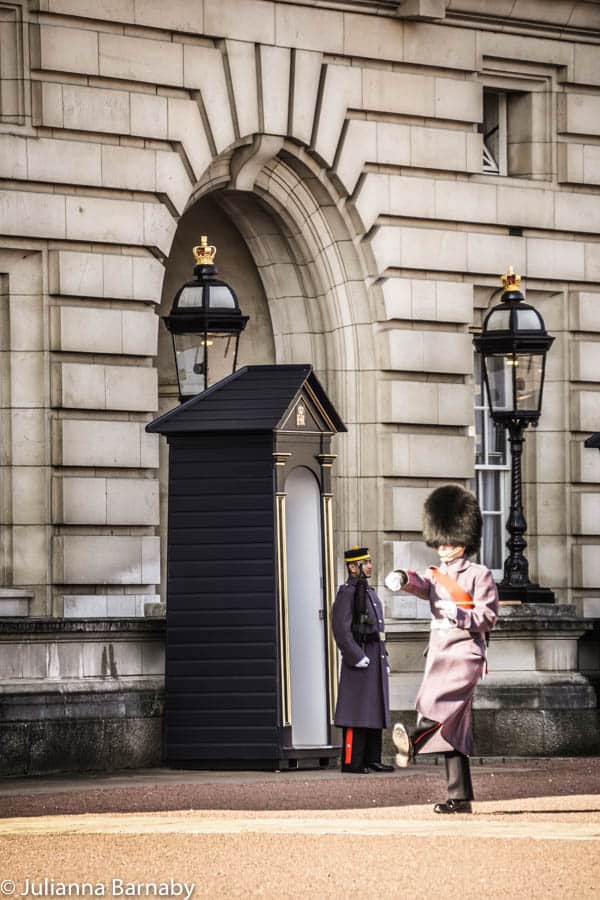
Changing of the Guard generally occurs on Sundays, Mondays, Wednesdays and Fridays between January and May and August to December. The ceremony happens daily in June and July.
The ceremony begins 10:45, though the actual handover happens at 11am. You’ll want to arrive a little bit earlier to secure yourself a great spot.
The main ceremony outside of Buckingham Palace lasts for around 40 minutes.
Schedule of the Ceremony
- 10.30am: The New Guard form for inspection at Wellington Barracks, then depart for Buckingham Palace once the Regimental Colour (flag) arrives.
- 10.40am: A Group of Old Guards leave Friary Court at St James’s Palace and march in formation to Buckingham Palace – often accompanied by a marching band or drum corps.
- 10.45am: The Old Guards from St James’s Palace arrive at Buckingham Palace and line up alongside the Buckingham Palace Old Guard detachment on the palace’s forecourt.
- 10.55am: The New Guards arrive at Buckingham Palace.
- 11:00am: Once in the forecourt of Buckingham Palace, The Old Guard and New Guard present their arms (salute with their rifles) to each other and exchange the keys to Buckingham Palace. The presentation of arms and exchange of keys marks the transfer of responsibility from the Old Guard to the New Guard.
- 11:00am – 11.30am: Music plays and Guards parade their regimental colours as the soldiers are inspected, Officers report to the Senior Captain and new sentries from the New Guard are posted. A duty Drummer informs the Director of Music that the handover has been completed and the band reform at the Centre Gates.
- 11.35am: The New Guards march into their positions at Buckingham and St James’s Palace. The Old Guards march back to Wellington Barracks.
The best chances for you to see soldiers on the march are when the New Guard arrives at the beginning of the ceremony and when the Old Guard leaves at the end.
There’s a lot of marching and music in between, but it can be difficult to see unless you have a prime position outside the palace or on the Victoria Memorial as it takes place inside the palace forecourt.
Changing of the Horse Guards
You can see the Changing of the Queen’s Life Guard ceremony at Horse Guards Parade at 11am during the week and at 10am on Sundays.
Horse Guards Parade is a ceremonial parade ground located just off Whitehall. It marks the formal entrance to both St James’s and Buckingham Palace.
It’s best-known for the smaller Guards Mounting ceremony that takes place in the courtyard, as well as for being the location of the annual Trooping the Colour ceremony.
The King’s Life Guard dates back to 1660 when King Charles II was restored to the throne and he decided to take steps to prevent him following in his father’s footsteps – they’ve been protecting the reigning monarch ever since.
Unlike the ceremony at Buckingham Palace, The Guards Mounting ceremony takes place daily at the Horse Guards (unless it’s cancelled due to bad weather).
The King’s Life Guard leaves the Barracks at Hyde Park at 10:28am sharp (or 9:28am on Sundays), passing through Hyde Park Corner, Constitution Hill, and The Mall. The changing of the guard ceremony takes place straight after.
Seeing the Ceremony in Windsor
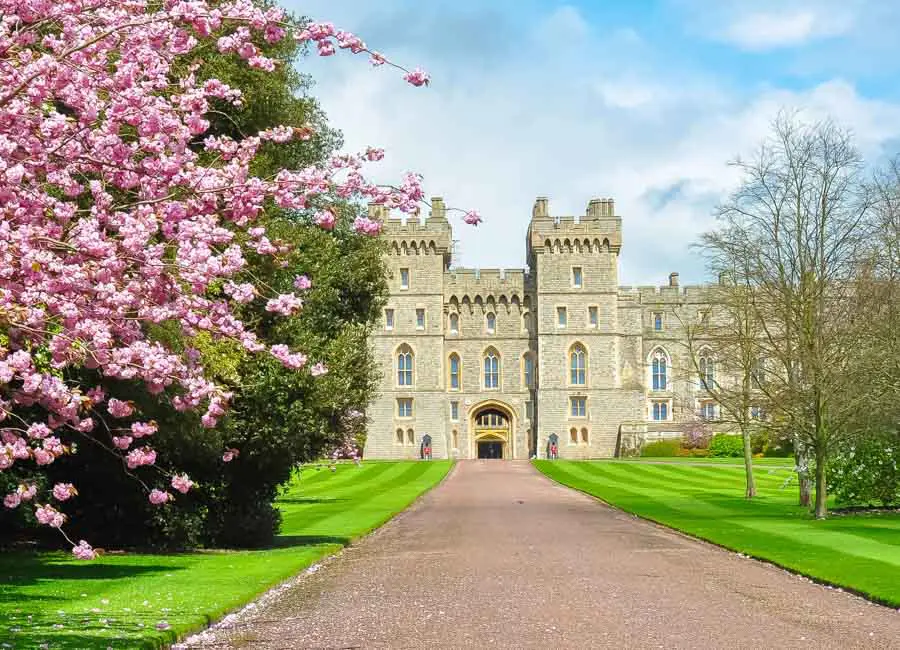
Combining a trip to Windsor with seeing the Changing of the Guards ceremony is easy.
The dates change every month; you should check this website to see which days of the week the ceremony will take place. It generally happens on Saturdays, Tuesdays and Thursdays for most of the year but can change – Sunday ceremonies are a rarity.
The best places to see the procession in Windsor without going into the castle is either on Windsor High Street or on Corn Exchange – from where the guards march to Windsor Castle.
If you want to see the ceremony itself, you need to buy a Windsor Castle ticket and head there for 11am (ideally just before). Get there early as it can get very busy, particularly during the warmer months.
The History of The Changing of The Guard
So why does all this happen? We Englihs love tradition – especially when it’s connected with our monarchy. As mentioned above, this tradition dates back to King Henry VII.
Origins
Henry VII initiated the Changing of the Guard ceremony when he was resident at the Tower of London. Since then, it has gone through many iterations, notably during the 17th century in the lead up to the English Civil War.
As Britain’s first permanent army was established, the New Model Army in 1645 by Parliamentarians and monarchist loyalists in favour of King Charles I, many historians see them as the precursors to the current King’s Guards.
Charles II and the Life Guards
The Guard Regiments, though (they’re the soldiers you’ll be seeing at the parade) were formed in 1656 to protect the exiled King Charles II. In 1660, once Oliver Cromwell’s Commonwealth had fallen and Charles II reclaimed the throne, he introduced his body guard to protect him (and, we assume, his head). This was the Life Guard, who continue to march at Buckingham Palace several times a week to guard the monarch.
Comprising the highly-trained officers and soldiers, the Guards Regiments are among the oldest units of the British Army and have served with distinction in almost every major conflict involving the Army since the 17th century.
During this period, the Changing of the Guard took place at the Palace of Whitehall before transferring to St James’s Palace in 1698 after the Palace of Whitehall burnt down.
Moving to Buckingham Palace
It was when Queen Victoria ascended to the throne and moved into Buckingham Palace in 1837 that the procession moved once again to its current main location, with a detachment of the Guard Regiments guarding it ever since.
The strength of the Guard is determined by whether or not the King is in residence. When the Royal Standard is flying above the Palace, the number of sentries increases. The same happens at Windsor Castle.
How Has the Ceremony Changed?
While there have been minor tweaks over the years (the addition of popular music being one), the truth is that the ceremony has barely changed over the years. If Charles II was to appear at the ceremony today, he’d feel right at home – aside from the change of location to Buckingham Palace, of course.
This minimal shift in the ceremony explains the striking outfits of the King’s Guards, who retain the traditional bearskin hats, red coats (in the summer), and ceremonial swords, rather than wearing their combat khaki kit.
Interestingly, Changing of the Guard is such a part of the fabric of London life that many people and businesses, even those within a stone’s throw of the palace are unaware of its existence.
With crowds around the palace, and along Whitehall par for the course throughout the day, the ceremony can take place almost unnoticed by those not ‘in the know’.
Did You Know?
- Although we refer to it as the Changing of the Guard – the ceremony’s proper name is actually “Guard Mounting.”
- The guards’ hats are a standard 18 inches tall and weigh 1.5 pounds each. They are made from Canadian brown bear pelts. Don’t worry, though, they are not hunted to order, but a product of legal and licensed hunting by provincial Canadian governments.
- If you get in the way of a guard, they won’t march around you – you will be instructed to “make way for the Queen’s Guards.” Refusal to move will see you unceremoniously barged out of the way.
- The guards are trained to deal with and ignore public nuisance. However, if absolutely necessary, they are permitted to point their weapons at a person and restrain them.
- When The King is in residence – a.k.a when he’s chilling at home – four sentries will guard Buckingham Palace. If there are only two guards, he’s probably off on her jollies somewhere (likely Windsor Castle, Balmoral, or Sandringham).
- The Household Guard is split into five regiments. While they might look the same at first glance, you can tell the difference by looking at the colour and placement of the plume on their hat and also at the spacing of their buttons. See if you can spot the difference. (Bonus points if you can!)
- The guards change their uniforms in the winter and summer months. The summer uniforms are the instantly-recognisable bright red tunics, but they wear a heavier muted-grey tunic during the winter months – far more practical for the colder weather. You’ll be glad to know that the bearskin hat stays all year round though.
Tips for Watching the Ceremony
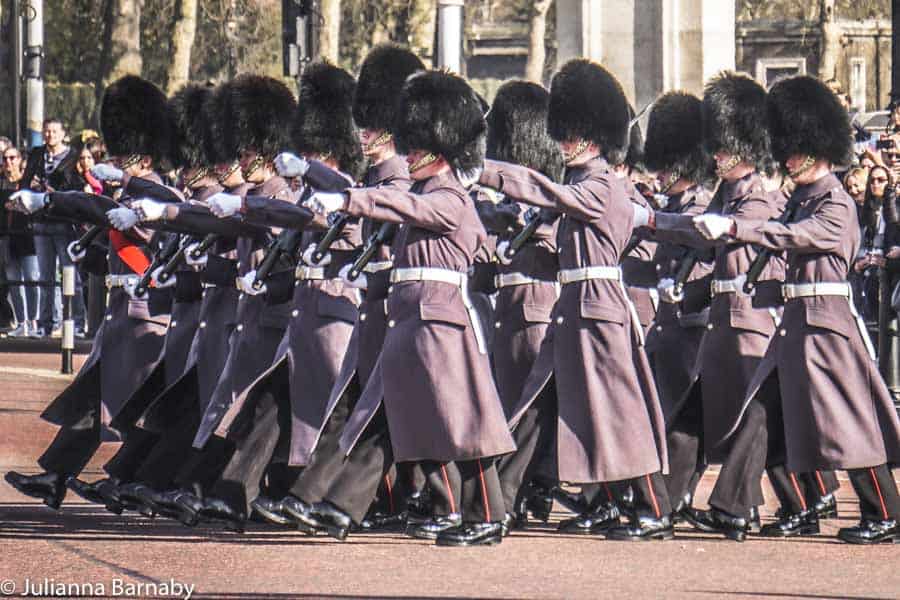
- Keep a close eye on your belongings. Keep them close to hand or secure as the ceremony is often targeted by pickpockets.
- You could get to Buckingham Palace really early to get a good position (like 45 minutes early), but then you will be standing and waiting around for ages before anything happens.
- We’d recommend turning up 10 minutes before everything kicks off – you probably won’t get the perfect vantage point, but it will be good enough – there’s pretty much no viewpoint where you won’t be able to see the New Guard marching up to the palace and the Old Guard marching away after they’ve been relieved.
- The ceremony can be cancelled at the last minute during bad weather (in Britain, the weather dictates our lives – this is no exception). If it looks like it’s going to be rainy, try and check ahead – but don’t be too disappointed if it’s cancelled shortly before it’s due to start. The best way to avoid being disappointed is to make sure there’s blue cloudless skies overhead half-an-hour before it all starts.
- Look at the flag being flown above Buckingham. If it’s the Royal Standard rather than the Union Jack, it means that the King is in residence at the palace. Who knows, maybe he’s peeking from behind the curtains and grabbing a snapshot of you for his Instagram feed.
- The nearest underground stations to Buckingham Palace are Victoria, St James’s Park and Green Park. It’s also a relatively easy walk from Hyde Park Corner and Marble Arch stations.
- We’ve given you more than enough information to arrange your visit, but if you want to book a guided tour to see behind the scenes, this one provides an informative and enjoyable experience.
![Changing of the Guard]](https://www.londonxlondon.com/wp-content/uploads/2020/03/Changing-of-the-Guard.jpg.webp)
Looking for More London Sightseeing Attractions??
- Fantastic London Sightseeing Tours To Help You Discover The Best of The City
- Interactive London Tourist Map – the City’s Biggest Sightseeing Attractions (+ Free Printable)
- Sightseeing in London: 39 Top London Attractions and Tips for Exploring Them
- 20+ Cool London Walking Tours to Help You Discover a Different Side of the City

